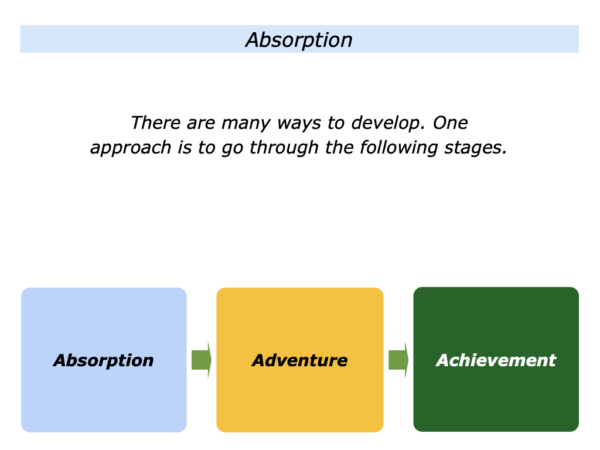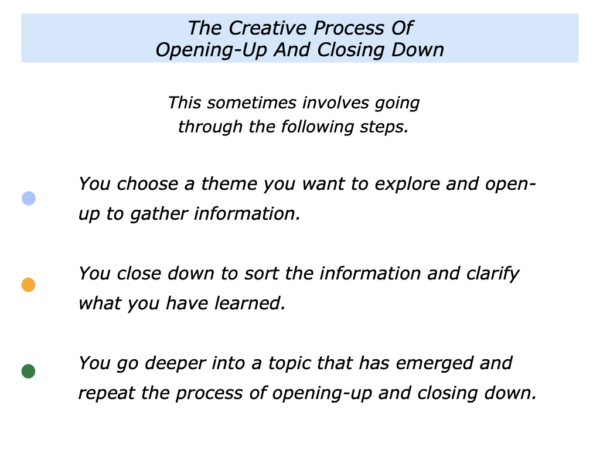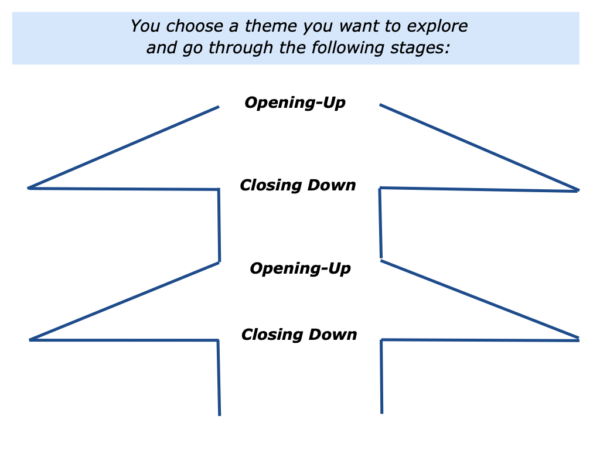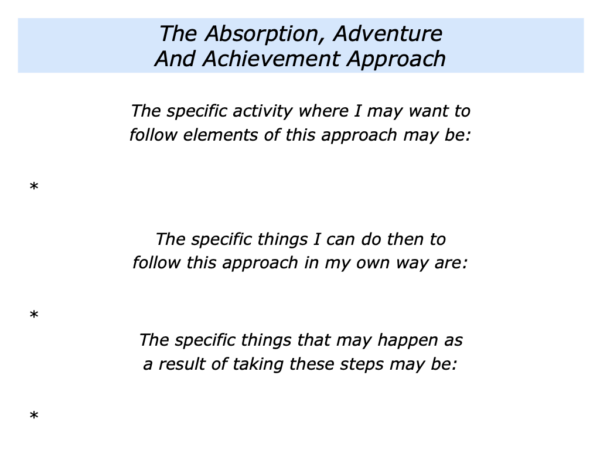
There are many ways to develop. One approach is to go through the stages of absorption, adventure and achievement.
You may take this approach when writing, gardening, painting, running or doing another activity. You may do so when encouraging a person, doing a project, running a workshop, leading a team or reframing a challenge.
People often feel alive when taking these steps. They enjoy the process of exploring, learning and creating. They may then reach their aim and enjoy a sense of achievement.
One key point is worth bearing in mind. Different people have different definitions of achievement. This can be useful to remember when encouraging other people to develop.
For some people achievement means enjoying an experience, helping others to grow or creating positive memories. For some it means gaining a badge, winning a prize or reaching a target. Let’s explore how you can explore some of these steps in your own way.
Absorption
Imagine that you want to absorb yourself in a specific activity. You may simply want to do it for pleasure or to experience joy. This can be good for the soul. It can you give you positive energy and be fulfilling.
You may want to translate your chosen activity into achieving a specific goal. This could be writing an article, renovating a house, developing a skill, solving a problem, tackling a challenge or your definition of success.
How can you absorb yourself in the activity? How can you move into action? How can you be fully engaged? How can you see it as a positive adventure?
Adventure
Maria Montessori, the educator, said that children often become absorbed in an activity. They apply themselves, learn and enjoy the adventure of being creative. Finally they reach their goal and experience a sense of achievement.
Imagine that you want to pursue a particular activity or project. You may set aside time to write, cook, sing or do mountain biking. You may aim to do a creative project, tackle a challenge or do another stimulating activity.
How can you use your abilities on the adventure? How can you build on your strengths? How can you improve your skills and add to your repertoire? How can you continue to develop?
Many people love to explore, learn and adventure. Sometimes this can involve pursuing the following aspects of the creative process.


Imagine that you are following this approach. You may start by choosing to focus on a particular theme you want to explore.
This will involve opening-up and gathering lots of information. After a while you will want to summarise what you have learned. This will lead to closing down and clarifying what you have learned.
The information you have gathered may reveal topics you want to explore in more depth. You may again go through the process of opening-up and closing down until you feel ready to move into action.
Clicking into action, you will build on your strengths and add what you have learned. Applying your skills, you will continue until you feel satisfied with the piece of creative work.
There are several points to bear in mind when following this approach. The first is knowing when to open-up and when to close down.
The second is knowing when to move into action. You will have gathered lots of knowledge but it will be important to apply this to shape the future. This can only be done by moving into action.
Sometimes you may not feel ready but decide to start the work. Believing that some answers may emerge on the journey, you say:
“Let’s crack on and do version 1.0”
Achievement
Imagine that you are pursuing an activity or doing a project. You will absorb yourself in the task and continue to develop. You may also work towards achieving a specific aim.
Sometimes the aim may be emotional. It may be to enjoy an experience or help others to take away positive memories. Sometimes the aim may be more tangible. It may be to see a finished product, achieve a target or lift a prize.
As mentioned earlier, people have different definitions of achievement. This is governed by what they set out to do. Bearing in mind what they can control, here are some things that people have said regarding what they want to achieve.
The specific things I want to achieve
by doing the activity or project are:
To regain my zest for life … To create nourishing meals that give people enjoyment … To provide a framework in which people can find fulfilment … To share knowledge that enables people to shape their futures.
To make music that some people find inspiring … To give people positive memories … To achieve a personal best in a triathlon … To lead a yachting team around the world and back home safely.
To produce three players every year who move from the Academy to the First Team … To make television films that encourage people to care for animals … To create a successful social enterprise … To build and sell a pioneering company.
How to take these steps? You will organise your time in your own way, but one model is similar to designing your perfect day. Let’s explore this approach.
My Development Day
Imagine you want to design a day when you set aside time to develop. What would it look like? Let’s consider some of the themes it can be useful to explore when designing such a day.
When do you feel most creative? What are your prime times – the times of the day when you have most creative energy? How can you organise your day around these times?
What is the physical place where you feel most creative? This could be a certain part of the house or another place. How can you continue putting yourself in these places?
What are things that can trigger your creativity? You may get ideas when walking, exercising, listening to music or other situations. How can you continue doing some of these things?
You will have your own approach to making use of such a day but here are some suggestions. You may wish:
To follow your chosen way to start the day – such as when to get up and do any practical tasks – and also focus on what you want to achieve that day;
To make good use of your prime times – the times of the day when you have most creative energy – and organise blocks of time when you can work during those times;
To follow your ritual for starting the work, follow your chosen rhythm and achieve small goals on the road to achieving the bigger goal;
To, when appropriate, rest and recharge your batteries – such as by going for a walk or doing other things – and then focus on what you want to do next;
To follow your successful pattern for finishing – such as one you have followed before to finish properly – then to flow, focus, finish and find fulfilment.
There are many ways to develop. One approach is to go through the stages of absorption, adventure and achievement. Looking ahead, can you think of a specific activity where you may want to follow elements of this approach?
If you wish, try tackling the exercise on this theme. This invites you to complete the following sentences.



Leave a Reply